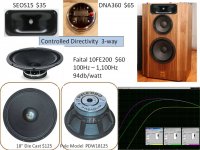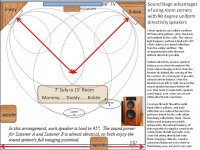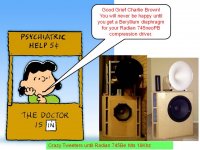Not really an issue here- the panel's not that thick and the driver beamwidth is surely very narrow by any freq it'd be an issue at.
Of course, I'd prefer if it were mounted against a beveled or rounded edge.
About 1.7 kHz is where diffraction will show itself with respect to the fullrange, if suppressed a bit in level when compared to the average because of directivity. Below 1.4 kHz it's sure to be an issue.
The tweeter also has a diffraction issue, though perhaps it's high enough in freq. that it's perceptually inconsequential.
The transitions on each, because of the "ripple" of the baffle structure, protrudes enough to be nearly 90 degrees, or a "hard" angle - particularly at horizontal positions.
Considering the dispersion of the whizzer for the fullrange portion - there will also be a *reflection*.
Basically the design itself, though structured for isolation of the drivers with respect to the box, has some problems that could have been at least mitigated but weren't. (..which sadly seems "par for the course" in many commercial offerings irrespective of price.
I couldn't say if any of it would be audible or not..
Last edited:
Qts=0.7 so open baffles only.Faitalpro 10FE200 Rms 0.75 less than 50€
Another contender in the high Qms and low Rms is the Seleneium 12PW5.
Rms .8
Qms 16.33
$90.00 at Parts-Express
Only thing that does not look good is the dip at ~450Hz.
..and similarly (as a 15"):
http://www.parts-express.com/pedocs/specs/264-464-selenium-15pw6-slf-specifications.pdf
-for $110.
Faitalpro 10FE200 Rms 0.75 less than 50€
The Faital 10FE200 models -3db ~70Hz in a sealed 1.8 - 2 cu ft enclosure, and looks like a good candidate for a 3-way midbass with other low cost speakers like the $35 SEOS15 waveguide + $65 DNA360 + $125 Pyle PDW18125.
A 90 x 40 SEOS waveguide allows a corner placement option.
Controlled directivity now often means delivering a wide enough sweet spot for a family on a couch watching an on-wall flat panel. Advertisements with a single guy in one chair with a flapping scarf have been replaced by home theater glitz.
Attachments
Another contender in the high Qms and low Rms is the Seleneium 12PW5.
Rms .8
Qms 16.33
$90.00 at Parts-Express
Only thing that does not look good is the dip at ~450Hz.
But the free air impedance phase graph looks like it's got issues to match the response, no? It's got blips around 120Hz, 375Hz, and everywhere above 1k.Usually the dip is given by the IEC baffle the driver is attached when measuring
I've spent a fair amount of time auditioning the AH425 and other LeCleac'h Azurahorns. Subjectively, not much happens off-axis ... there's no sudden change, the sound just loses a bit of focus ... it's quite not as sharp and crisp. But it's a fairly small change compared to most other horns I've auditioned, which can sound very different as you walk around the room (for example, when you walk out of the beam of a conical horn).
Subjectively, it sounded best slightly off-axis, with about half of the throat of the compression driver visible from the listening position. By measurement, there's not much change over a 10-degree span, and no on-axis suckout or other weirdness to deal with. As get further off-axis, it just rolls off earlier, with no sudden change, and this continues even when you get way, way off-axis, like 90 degrees, or even behind the loudspeaker. It basically acts like a fairly big dome tweeter in terms of directivity, not like a horn at all.
I usually "voice" speakers using pink-noise, aiming for natural sound at all possible listening positions, and going to some trouble to avoid obvious whistling phasey sounds when well off-axis. This is where conicals and exponentials can be troublesome: if EQ'ed for good behavior over a frontal 45-degree sweep, they can get pretty weird at 60, 90, and 120 degrees off-axis, with very strange impulse and frequency response. The LeCleac'h T=0.707 just rolls off, with no deep nulls or peaks when far off-axis.
Part of the reason I take this approach is consideration of the first several reflections that arrive at the listening position. They're not hard to work out: the first will be the floor bounce, which arrives between 2.5 to 3 mSec after the direct sound, and is only very slightly attenuated (1 dB or less) by carpeting. The next will probably be the ceiling reflection (unless it's a 10-foot or higher ceiling), arriving 3 to 5 mSec after the direct sound.
The next several reflections depend on the location of the speaker in the room. If the speaker is reasonably well away from the sidewalls (highly recommended), the next reflection will be from behind the speaker. The timing of this depends on the depth of the speaker and the distance to the rear wall. These are large speakers, which will probably be 6 to 12 inches away from the rear wall, so the rear-wall reflection will be delayed by about 5 to 6 mSec or so. (1 millisecond is fairly close to 14 inches.)
The (nearest) side wall reflection will obviously depend on the distance from the side wall. Placing the speaker closer than 1 to 2 feet away from the side wall will degrade imaging, regardless of polar pattern, partially because the bass below 500 Hz is nearly omnidirectional, regardless of fancy techniques used for the HF section.
(Full-range dipoles are a special case, but even dipoles don't do well in corners. Bass horns retain pattern control at lower frequencies, but a bass horn that is pattern-controlled down to 100 Hz is starting to get too large for domestic applications.)
So it's not a mystery where the first reflections will come from. We can work backward from this and work out the emission angle of each reflection: the floor reflection is vertically off-axis by 20 to 30 degrees, the ceiling reflection is vertically off-axis by a little more, and the rear-wall reflection is around 150 to 180 degrees off-axis. The emission angle into the nearest side wall will be around 90 degrees off-axis (if the speakers are aimed at the listener).
Rotating the speakers will have a strong effect on the emission angle going into the side walls, as well as affecting the emission angle for the first-arrival sound. Speaker rotation (toe-in) alters the level and spectral balance of the side wall reflection versus the direct-arrival sound. Most speakers are not optimized for smooth response 90 degrees off-axis, so this can be a rather critical adjustment for the consumer.
Note that nearly all of the reflections in the first 6 to 8 mSec are far off-axis, and do not fall in the traditional elliptical 45 to 60-degree "sweet spot". If the response from the floor, ceiling, rear, or side wall is peaky (or drastically different than the direct-arrival spectra), yes, it will be audible on pink-noise as you move around the room.
The other thing that can happen is the loudspeaker will be extremely sensitive to small changes in room location and rotation/toe-in, since this alters the phase angle of the first several reflections as they arrive at the listening position. If any of these first reflections has deep nulls or peaking (relative to the direct-arrival spectra), that will create an impression of phasiness on pink-noise or music that has a dense spectra, thanks to comb-filtering between the first-arrival sound and the reflection with an erratic spectra (for example, the reflection off the rear wall).
Subjectively, it sounded best slightly off-axis, with about half of the throat of the compression driver visible from the listening position. By measurement, there's not much change over a 10-degree span, and no on-axis suckout or other weirdness to deal with. As get further off-axis, it just rolls off earlier, with no sudden change, and this continues even when you get way, way off-axis, like 90 degrees, or even behind the loudspeaker. It basically acts like a fairly big dome tweeter in terms of directivity, not like a horn at all.
I usually "voice" speakers using pink-noise, aiming for natural sound at all possible listening positions, and going to some trouble to avoid obvious whistling phasey sounds when well off-axis. This is where conicals and exponentials can be troublesome: if EQ'ed for good behavior over a frontal 45-degree sweep, they can get pretty weird at 60, 90, and 120 degrees off-axis, with very strange impulse and frequency response. The LeCleac'h T=0.707 just rolls off, with no deep nulls or peaks when far off-axis.
Part of the reason I take this approach is consideration of the first several reflections that arrive at the listening position. They're not hard to work out: the first will be the floor bounce, which arrives between 2.5 to 3 mSec after the direct sound, and is only very slightly attenuated (1 dB or less) by carpeting. The next will probably be the ceiling reflection (unless it's a 10-foot or higher ceiling), arriving 3 to 5 mSec after the direct sound.
The next several reflections depend on the location of the speaker in the room. If the speaker is reasonably well away from the sidewalls (highly recommended), the next reflection will be from behind the speaker. The timing of this depends on the depth of the speaker and the distance to the rear wall. These are large speakers, which will probably be 6 to 12 inches away from the rear wall, so the rear-wall reflection will be delayed by about 5 to 6 mSec or so. (1 millisecond is fairly close to 14 inches.)
The (nearest) side wall reflection will obviously depend on the distance from the side wall. Placing the speaker closer than 1 to 2 feet away from the side wall will degrade imaging, regardless of polar pattern, partially because the bass below 500 Hz is nearly omnidirectional, regardless of fancy techniques used for the HF section.
(Full-range dipoles are a special case, but even dipoles don't do well in corners. Bass horns retain pattern control at lower frequencies, but a bass horn that is pattern-controlled down to 100 Hz is starting to get too large for domestic applications.)
So it's not a mystery where the first reflections will come from. We can work backward from this and work out the emission angle of each reflection: the floor reflection is vertically off-axis by 20 to 30 degrees, the ceiling reflection is vertically off-axis by a little more, and the rear-wall reflection is around 150 to 180 degrees off-axis. The emission angle into the nearest side wall will be around 90 degrees off-axis (if the speakers are aimed at the listener).
Rotating the speakers will have a strong effect on the emission angle going into the side walls, as well as affecting the emission angle for the first-arrival sound. Speaker rotation (toe-in) alters the level and spectral balance of the side wall reflection versus the direct-arrival sound. Most speakers are not optimized for smooth response 90 degrees off-axis, so this can be a rather critical adjustment for the consumer.
Note that nearly all of the reflections in the first 6 to 8 mSec are far off-axis, and do not fall in the traditional elliptical 45 to 60-degree "sweet spot". If the response from the floor, ceiling, rear, or side wall is peaky (or drastically different than the direct-arrival spectra), yes, it will be audible on pink-noise as you move around the room.
The other thing that can happen is the loudspeaker will be extremely sensitive to small changes in room location and rotation/toe-in, since this alters the phase angle of the first several reflections as they arrive at the listening position. If any of these first reflections has deep nulls or peaking (relative to the direct-arrival spectra), that will create an impression of phasiness on pink-noise or music that has a dense spectra, thanks to comb-filtering between the first-arrival sound and the reflection with an erratic spectra (for example, the reflection off the rear wall).
Last edited:
But the free air impedance phase graph looks like it's got issues to match the response, no? It's got blips around 120Hz, 375Hz, and everywhere above 1k.
found another measurement:
An externally hosted image should be here but it was not working when we last tested it.
the dip is still there, albeit less deep
..most other horns I've auditioned, which can sound very different as you walk around the room (for example, when you walk out of the beam of a conical horn)..
TAD + Goto horns - YouTube
It seems to me the LeCleach type expansion is quite ideal although I have never auditioned them. What I like is the expansion from compression driver through the horn is gradual and seems closer to natural expansion. This expansion curve shaping has great effect on damping of stored energy at the throat's low frequency performance.
just got a real good deal off ebay for a pair of these ($70 - shipping included)!
seller still has more.
now i need to add a pair of woofers for the bottom end. what about the jbl 2225?
will add subs later.
Some interesting comments from Joachim Gerhard that cover parts of the discussions we had here last week (high Qms/low Rms, and trend in modern drivers)
SpeakerBuilding.com - Interview with Joachim Gerhard of Audio Physic
SpeakerBuilding.com - Interview with Joachim Gerhard of Audio Physic
Later, in the 80's, manufacturers started to add more mass, they added more damping, and they made surrounds with high loss. That gave an extremely flat frequency response, but also a lot of energy storage. This compared, the old drivers were much quicker. They had some resonances, but you could get rid of that in the crossover. It was this run for flat response that gave a lot of modern drivers this dull, uninteresting sound. And you can also measure higher second and third harmonic distortion in some of them. If you compare the on-axis response between an old and new driver; you will see that the energy in the treble is far higher than in the new drivers. These so-called "modern" drivers often has a Qms of maybe 0.8 or 0.6. The old drivers had Qms values of maybe 5 to 7! We found that drivers with a very high mechanical Q sound more open, more clean and dynamic. And when you look at it, you find it is very simple, because they have less loss. The surround is easier to move, the spider is better constructed, they have better air flow, higher sensitivity. So a high mechanical Q is a very good indicator of energy storage behavior. This is one of our secrets. One of the many!
I wish I could get a straight answer on their exit angle.just got a real good deal off ebay for a pair of these ($70 - shipping included)!
seller still has more.
will add subs later.
While I agree with the general thrust of the article (which I read many years ago btw) that drivers that achieve their target Qts with a high Qms often sound better, the statement I've highlighted is pure nonsense.Some interesting comments from Joachim Gerhard that cover parts of the discussions we had here last week (high Qms/low Rms, and trend in modern drivers)
Later, in the 80's, manufacturers started to add more mass, they added more damping, and they made surrounds with high loss. That gave an extremely flat frequency response, but also a lot of energy storage.
SpeakerBuilding.com - Interview with Joachim Gerhard of Audio Physic
How exactly does adding a more lossy surround and achieving a lower Qms increase "energy storage" ? It doesn't, it decreases it, by definition.
The overall energy storage at bass frequencies is going to be dictated by the Qts anyway not Qms alone.
I suspect what's really going on is that drivers with low Rms and high Qms have reduced suspension hysteresis effects in the final output at low drive levels due to their overall cone "control" being more heavily electrical (Qes) rather than mechanical. (Qms) Because of this the effects of any level dependent hysteresis and other odd time variant non-linear effects of the suspension are minimised.
Last edited:
While I agree with the general thrust of the article (which I read many years ago btw) that drivers that achieve their target Qts with a high Qms often sound better, the statement I've highlighted is pure nonsense.
How exactly does adding a more lossy surround and achieving a lower Qms increase "energy storage" ? It doesn't, it decreases it, by definition.
Actually he said: (highlight mine)
Later, in the 80's, manufacturers started to add more mass, they added more damping, and they made surrounds with high loss. That gave an extremely flat frequency response, but also a lot of energy storage.
And because more mass equals more energy E=m*c^2, you know
- Home
- Loudspeakers
- Multi-Way
- Beyond the Ariel


